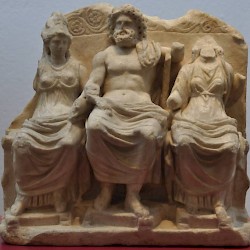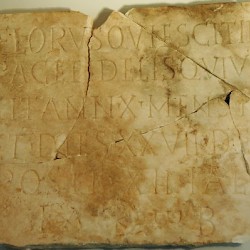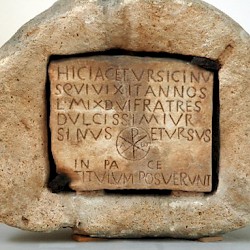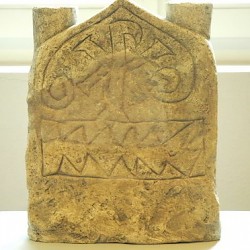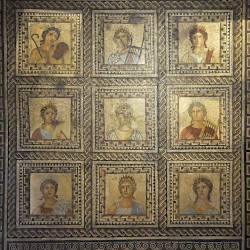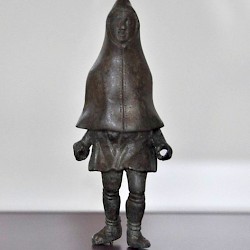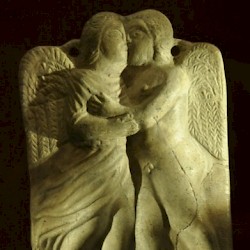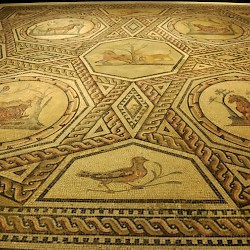Augusta Treverorum (Trier)
Q3138Augusta Treverorum: important Roman city, modern Trier.
Early History
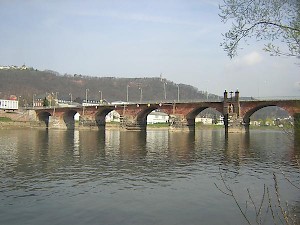
The foundation of Trier's prosperity was trade on the river Moselle, which is part of that great artery of pre-industrial Europe: the corridor of Rhine, Moselle, Saône, and Rhône. Trade made the tribe of the Treveri powerful, but Trier was not yet an important city in the Late Iron Age. before the Roman conquest, the most important settlement of the Treveri probably was the hillfort at the Titelberg.
Trier rose to prominence only when the Roman general Agrippa built the road from Lyon to Cologne (39 BCE). The construction of a temporary military settlement on the nearby Petrisberg, a hill east of the city, appears to be a bit younger.note In 17 BCE, a bridge was constructed near the place where the Saar empties itself in the Moselle. The bridge, which was rebuilt in the second century, has survived and is still in use.
The Romans called the city Augusta Treverorum, "the august city of the Treveri". It appears to have had the rank of colonia and was the seat of the procurator who was responsible for Gallia Belgica, Germania Superior, and Germania Inferior. The size of the forum, 275x135 meter, is an indication of the importance of the market: this was an important economic center. The city also had an amphitheater for gladiatorial contests and a circus. The river port has been identified downstream from the bridge. A double granary has been excavated, and it comes as no surprise that Trier may have had as many as 50,000 inhabitants, who needed more food than the immediate surroundings could produce. The area inside the walls was about 285 hectare, which means that Trier was a large city.
High Empire
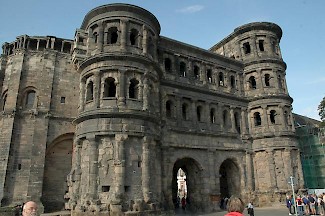
The city was in the front line during the Batavian Revolt (70 CE), when Petillius Cerialis defeated a rebel army near Trier, and in 196/197, when it played a role during the war between Septimius Severus and Clodius Albinus, but generally, the first and second centuries were quiet. After c.150, the city expanded and received its wall. There were at least three bathhouses: the Baths of Barbara, the thermae of the Viehmarkt, and the fourth-century Imperial Baths.
The Germanic invasions of the second half of the third century, however, were an altogether different affair. The tribal warriors looted the valley of the Moselle in 256, and Trier - although surrounded by a strong wall with impressive gates like the Porta Nigra - was sacked. After the glorious interlude of the Gallic Empire, when Gaul was independent from Rome, the city burned again in 274, after Aurelian had added Gaul to the Empire again and had stripped the Rhine frontier from its defenders. Later, however, a cavalry unit was to protect Trier, which had hitherto been ungarrisoned.
Late Antiquity
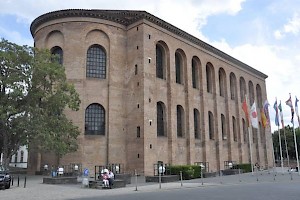
During the reign of the emperors Maximianus (286-305) and Constantius Chlorus (293-306) Trier was made the capital of the prefecture of Gaul. Constantine stayed in the city too. Several buildings, worthy of an imperial residence, were erected in the course of the fourth century, especially after 326: the Imperial Baths and the Imperial Basilica survive, and the ruins of an ancient church have been discovered underneath the cathedral. There was an important mint, and several learned people (e.g., Lactantius and Ausonius) are known to have stayed at the imperial court.
During and after the reign of Constantine, the Roman Empire became Christian. One of the first Christian leaders in the Rhineland was Maternus, citizen of Trier and bishop of Cologne. Athanasius, Jerome and Ambrose are known to have visited the city on the banks of the Moselle, and must have visited this imperial basilica and the double church that was erected on the site of an earlier palace. In the apse, a statue of the emperor must have stood. The famous meeting between Martin of Tours and the emperor Magnus Maximus took place in Trier (384).
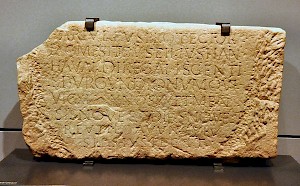
The city suffered several times from violence. In 353, the usurper Magnentius besieged the city (in vain) and in 360, Germanic tribes sacked Trier. Yet, the city continued to exist, and the imperial court was still there. Texts like the Hariulf Inscription prove that, although the relations could be dangerous enemies, Rome was still capable of assimilating them.
Decline
The city suffered worse when the imperial court was moved to Arles in 394; one year later, the mint was closed. The city was essentially left to its own, and was mercilessly attacked by the Germanic tribes, who broke through after 406. It was sacked four times between 410 and 435, and was captured by the Huns in 451. Why Rome was no longer capable of assimilating the Germans and why Rome collapsed, has been a matter of dispute ever since.
After the fall of the Roman empire, Trier became the capital of a Frankish princedom (485), which was later included in the larger kingdom of Clovis.
